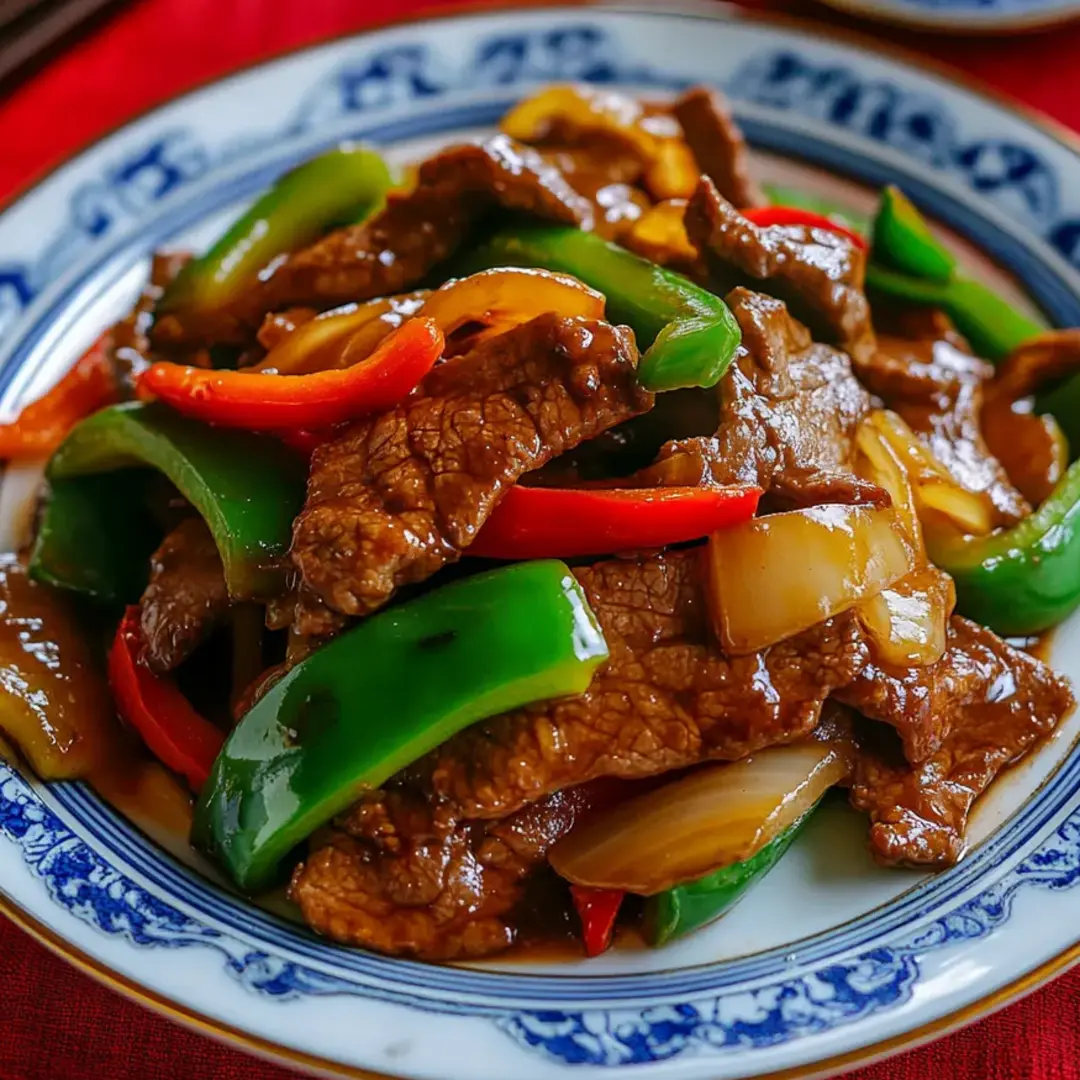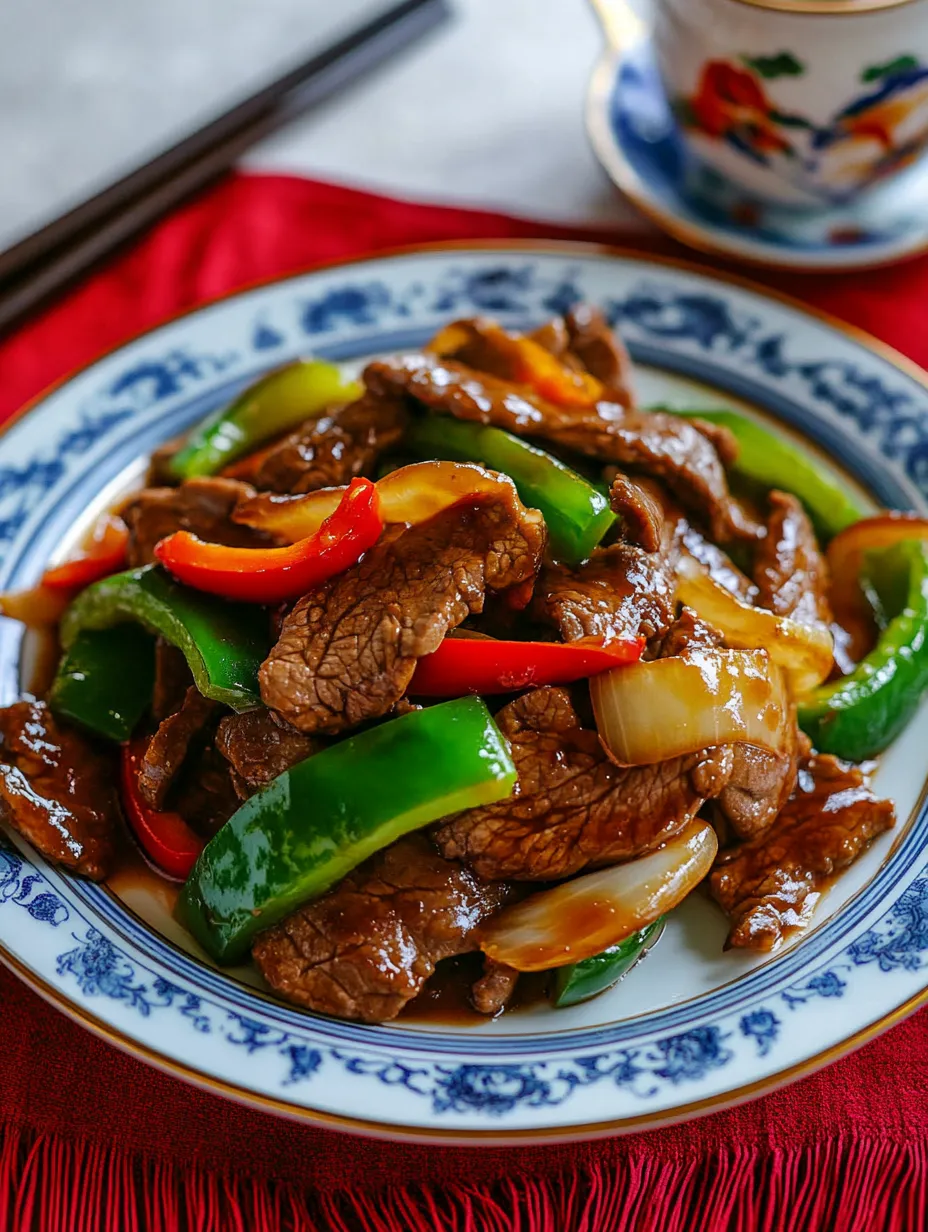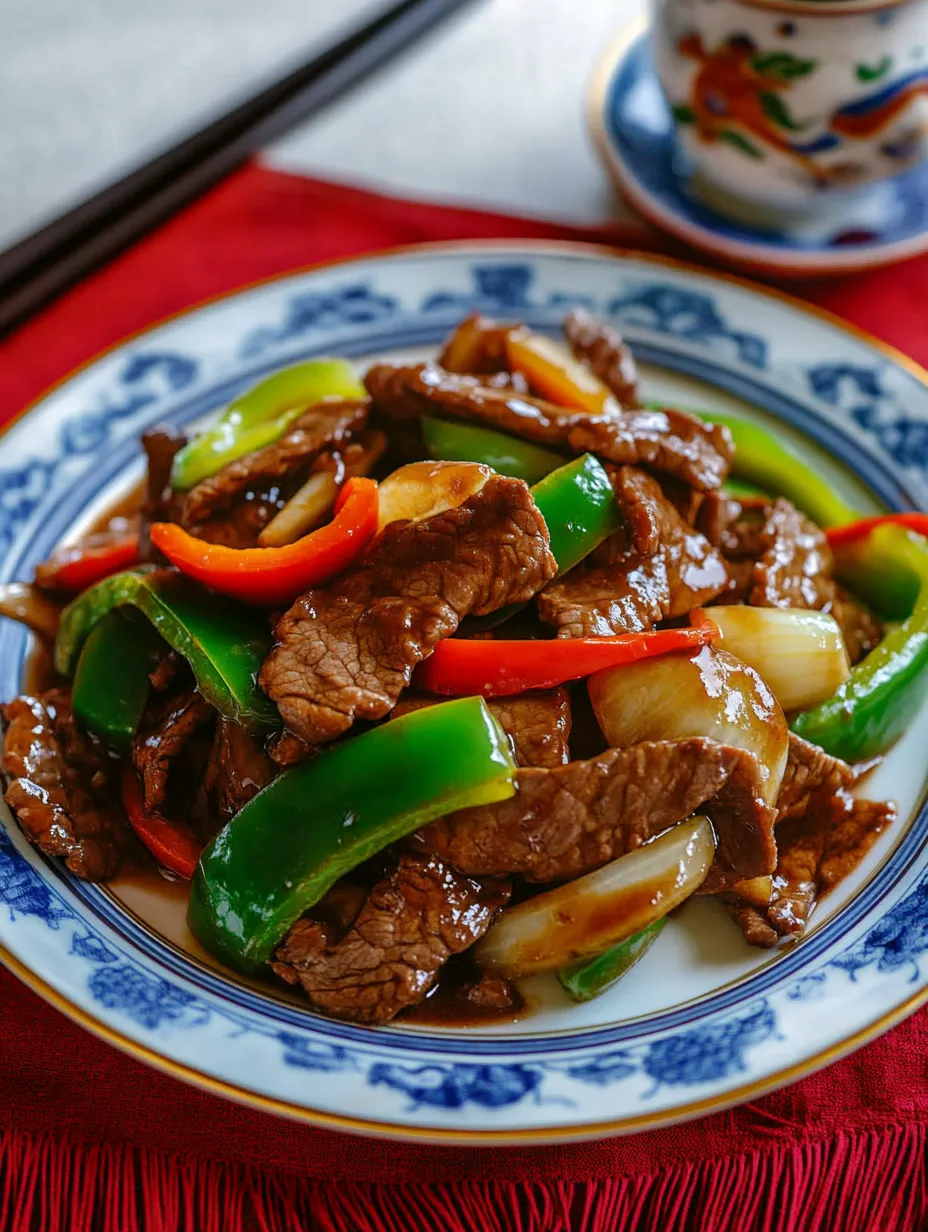 Pin it
Pin it
This vibrant Chinese Pepper Steak brings together tender strips of beef with colorful bell peppers in a savory-sweet sauce that coats each ingredient perfectly. The combination creates a balanced meal that satisfies both nutritional needs and flavor cravings, making it ideal for weeknight dinners when you want something substantial yet quick. Served over fluffy rice that soaks up all the delicious sauce, this stir-fry delivers restaurant-quality taste with simple home cooking techniques that anyone can master.
I first made this pepper steak on a rainy Tuesday when I was craving Chinese takeout but didn't want to leave the house. My husband, who typically reaches for seconds of anything with potatoes or pasta, surprised me by going back for a third helping of this colorful stir-fry. When our teenage son, who declares most vegetables 'suspicious,' cleaned his plate without complaint, I knew this recipe had earned a permanent spot in our dinner rotation.
Key Ingredients
- Beef: Flank steak offers the perfect balance of flavor and tenderness; slice it thinly against the grain for the best texture
- Bell peppers: Using a mix of red, green, and yellow creates vibrant color contrast and slightly different flavor notes from each
- Onion: Adds sweetness and depth; yellow onions work best but white onions provide a sharper flavor if preferred
- Garlic and ginger: These aromatic foundations create that distinctive Chinese flavor profile; fresh versions provide significantly better results than dried
- Soy sauce: Provides the savory umami base for the sauce; use low-sodium if you're watching salt intake
- Oyster sauce: Adds richness and complexity that can't be matched by other ingredients; vegetarian versions are available if needed
- Brown sugar: Just a touch balances the saltiness of the soy and adds subtle caramelization to the sauce
- Sesame oil: Used as a finishing oil rather than for cooking, its distinct nutty flavor is essential to authentic taste
- Corn starch: Creates that perfect sauce consistency that clings to every piece of meat and vegetable
 Pin it
Pin it
Detailed Cooking Instructions
- Step 1:
- Begin with preparing your beef properly using the velveting technique. Pat 1½ pounds of flank steak dry with paper towels to remove excess moisture, then place it on a cutting board. Using a sharp knife, slice the steak against the grain into thin strips approximately ¼-inch thick. Cutting against the grain shortens the muscle fibers, creating more tender meat even before cooking.
- Step 2:
- Transfer the sliced beef to a medium bowl and sprinkle with 1 teaspoon of baking soda. Using clean hands or tongs, gently toss the meat until all pieces are lightly coated. This alkaline ingredient will break down the proteins on the surface of the meat, creating an incredibly tender texture. Cover the bowl with plastic wrap and refrigerate for 30 minutes.
- Step 3:
- After 30 minutes, remove the beef from the refrigerator and rinse thoroughly under cold running water to remove all traces of baking soda. Rinse several times to ensure no residual baking soda remains, as it can affect the flavor. Pat the meat dry with paper towels – this is crucial for proper browning during cooking.
- Step 4:
- In a small bowl, prepare the sauce by combining ⅓ cup low-sodium soy sauce, 2 tablespoons oyster sauce, 1 tablespoon brown sugar, 1 tablespoon rice vinegar, and 1 teaspoon sesame oil. Whisk until the sugar dissolves completely. In a separate small bowl, create a slurry by mixing 1 tablespoon cornstarch with 2 tablespoons water until smooth. Set both mixtures aside.
- Step 5:
- Heat a large wok or heavy skillet over high heat until it's very hot – you should see wisps of smoke rising from the surface. Add 1 tablespoon of vegetable or peanut oil and swirl to coat the cooking surface. The high heat is essential for proper stir-frying technique, creating that distinctive wok hei flavor.
- Step 6:
- Add the dried beef in a single layer, being careful not to overcrowd the pan. You may need to cook in batches depending on the size of your wok. Allow the beef to sear undisturbed for 1 minute before stirring. This creates a beautiful caramelization on the surface while keeping the inside tender. Stir-fry for just 2-3 minutes total until the beef is browned but not fully cooked. Remove to a clean plate and set aside.
- Step 7:
- In the same wok, add another tablespoon of oil if needed. Add 1 sliced yellow onion and stir-fry for 1 minute until it begins to soften but still maintains some crispness. Push the onions to one side of the wok, then add 2 minced garlic cloves and 1 tablespoon freshly grated ginger to the cleared space. Stir these aromatics for just 30 seconds until fragrant but not browned, then mix with the onions.
- Step 8:
- Add 3 bell peppers (one each of red, green, and yellow) cut into 1-inch squares. Stir-fry for 2-3 minutes until the peppers are bright in color and crisp-tender. The goal is not to fully soften them but to maintain some texture for a satisfying bite.
- Step 9:
- Return the beef to the wok, including any accumulated juices from the plate. These juices contain valuable flavor that will enhance your sauce. Toss everything together to combine and heat through for about 1 minute.
- Step 10:
- Give your sauce mixture a quick whisk to recombine any settled ingredients, then pour it around the edges of the wok rather than directly onto the ingredients. This allows the sauce to heat up as it travels down the sides of the hot wok. Stir everything constantly as the sauce begins to bubble.
- Step 11:
- Once the sauce is bubbling, give your cornstarch slurry another quick stir (it settles quickly), and drizzle it into the wok while stirring continuously. The sauce will begin to thicken almost immediately. Continue stirring for about 1-2 minutes until the sauce reaches your desired consistency, coating every piece of meat and vegetable with glossy perfection.
- Step 12:
- Remove from heat and serve immediately over steamed rice. Garnish with thinly sliced green onions and a sprinkle of toasted sesame seeds for added texture and visual appeal.
The Science Behind Velveting
The velveting technique is truly a game-changer for home cooks looking to achieve that distinctive restaurant-quality tenderness in their stir-fries. While it might seem like an extra step, the science behind it makes it worth every second. The alkaline nature of baking soda raises the pH level on the surface of the meat, making it difficult for proteins to bond tightly during cooking. This chemical reaction prevents the meat from seizing up and becoming tough when exposed to high heat. I've experimented with skipping this step, and the difference is remarkable – velveted beef remains tender and juicy even after a quick stir-fry, while untreated beef can become chewy and dry.
 Pin it
Pin it
Making It Your Own
What I love most about this pepper steak recipe is its flexibility. When bell peppers are expensive in winter, I've substituted with whatever vegetables were available – snow peas add a lovely crunch, broccoli florets work beautifully, and sliced mushrooms bring an earthy depth. For extra heat, I sometimes add thinly sliced fresh jalapeños along with the bell peppers or a teaspoon of chili oil to the sauce. My husband prefers a sweeter profile, so occasionally I'll add an extra teaspoon of brown sugar and a tablespoon of pineapple juice to the sauce. Don't be afraid to adjust the flavors to suit your family's preferences.
Perfect Rice Pairing
While this pepper steak shines on its own, serving it over the right rice elevates the entire experience. Long-grain jasmine rice, with its subtle floral aroma, complements the savory flavors wonderfully. For a nutrition boost, I often use brown jasmine rice, which adds a pleasant nuttiness and extra fiber. The key to perfect rice is rinsing it thoroughly before cooking to remove excess starch, then allowing it to rest covered for 10 minutes after cooking before fluffing with a fork. This resting period allows the moisture to distribute evenly, resulting in perfectly tender grains that provide the ideal base for soaking up the delicious sauce.
I discovered by happy accident that a splash of orange juice added to the sauce creates an amazing flavor dimension reminiscent of orange beef. Now when I have an orange on hand, I often add a tablespoon of fresh juice and some zest to the sauce for a bright citrus note that complements the savory elements beautifully.
This Chinese Pepper Steak has become more than just a recipe in our home – it's the solution to 'what's for dinner' debates and the meal I know will please everyone at the table without hours in the kitchen. There's something deeply satisfying about creating a balanced, colorful dish that delivers restaurant-quality flavors using simple techniques. Whether you're trying to incorporate more vegetables into family meals or simply looking for a reliable weeknight recipe that doesn't sacrifice flavor for convenience, this pepper steak delivers on all fronts.
Frequently Asked Questions
- → What is the velveting technique and why is it important?
- Velveting is a Chinese cooking technique that uses baking soda to tenderize meat. It breaks down proteins, resulting in incredibly tender beef that maintains its moisture during high-heat stir-frying.
- → Can I substitute the Shaoxing wine with something else?
- Yes, you can substitute Shaoxing wine with dry sherry or even a bit of rice vinegar mixed with water. In a pinch, you could use a tablespoon of broth with a splash of white vinegar.
- → What's the difference between light and dark soy sauce?
- Light soy sauce is thinner and saltier, while dark soy sauce is thicker, less salty, and adds a rich color to dishes. If you only have regular soy sauce, that's fine too – just adjust the saltiness to taste.
- → Can I make this dish ahead of time?
- Yes, you can prepare the components ahead of time: slice the beef and vegetables, and mix the sauce. Store separately in the refrigerator. The actual stir-frying should be done just before serving for the best texture.
- → What vegetables can I add or substitute in this recipe?
- Feel free to add or substitute with vegetables like broccoli, snow peas, mushrooms, carrots, or celery. Just adjust cooking times as needed – harder vegetables need more time, while tender ones cook quickly.
